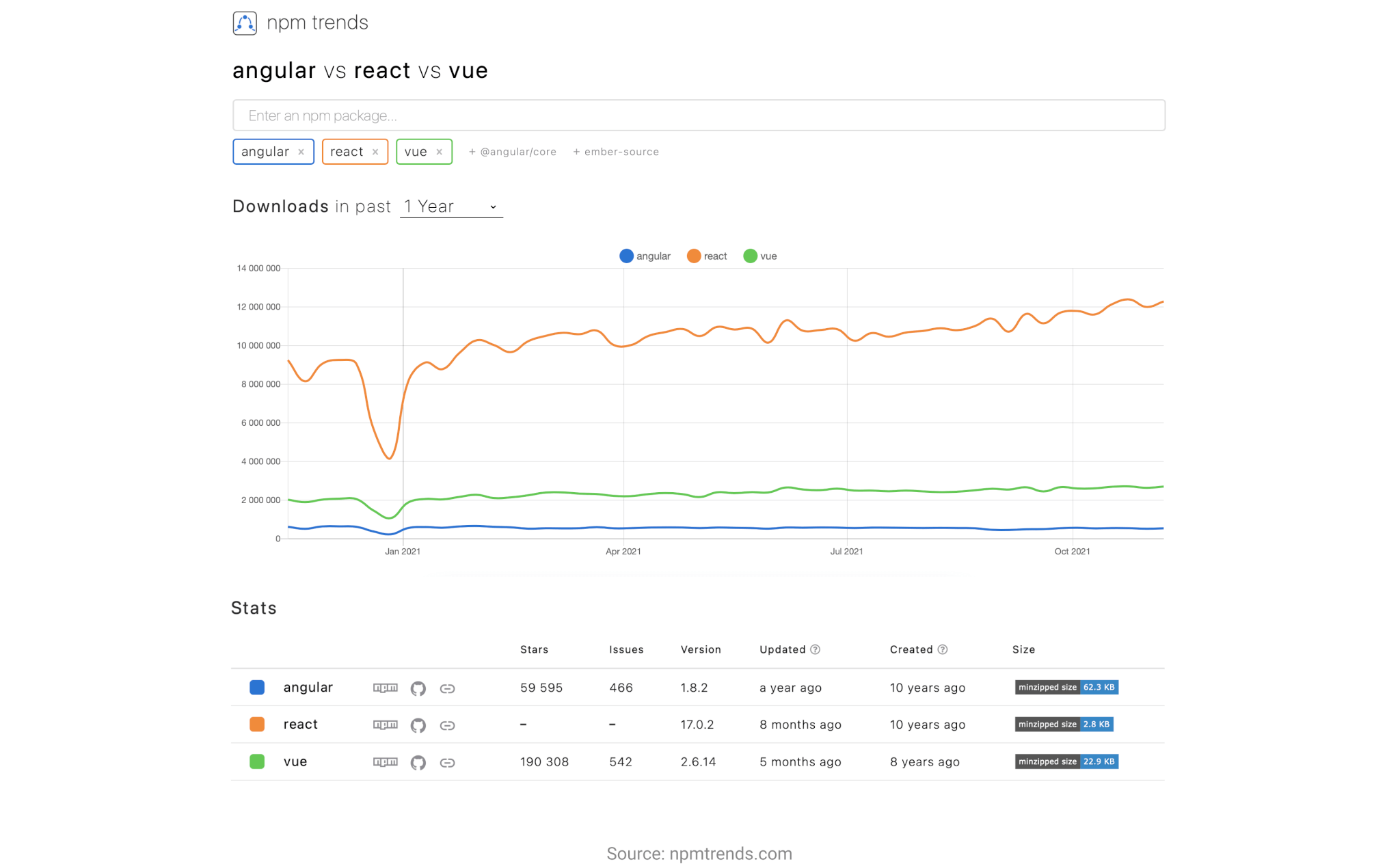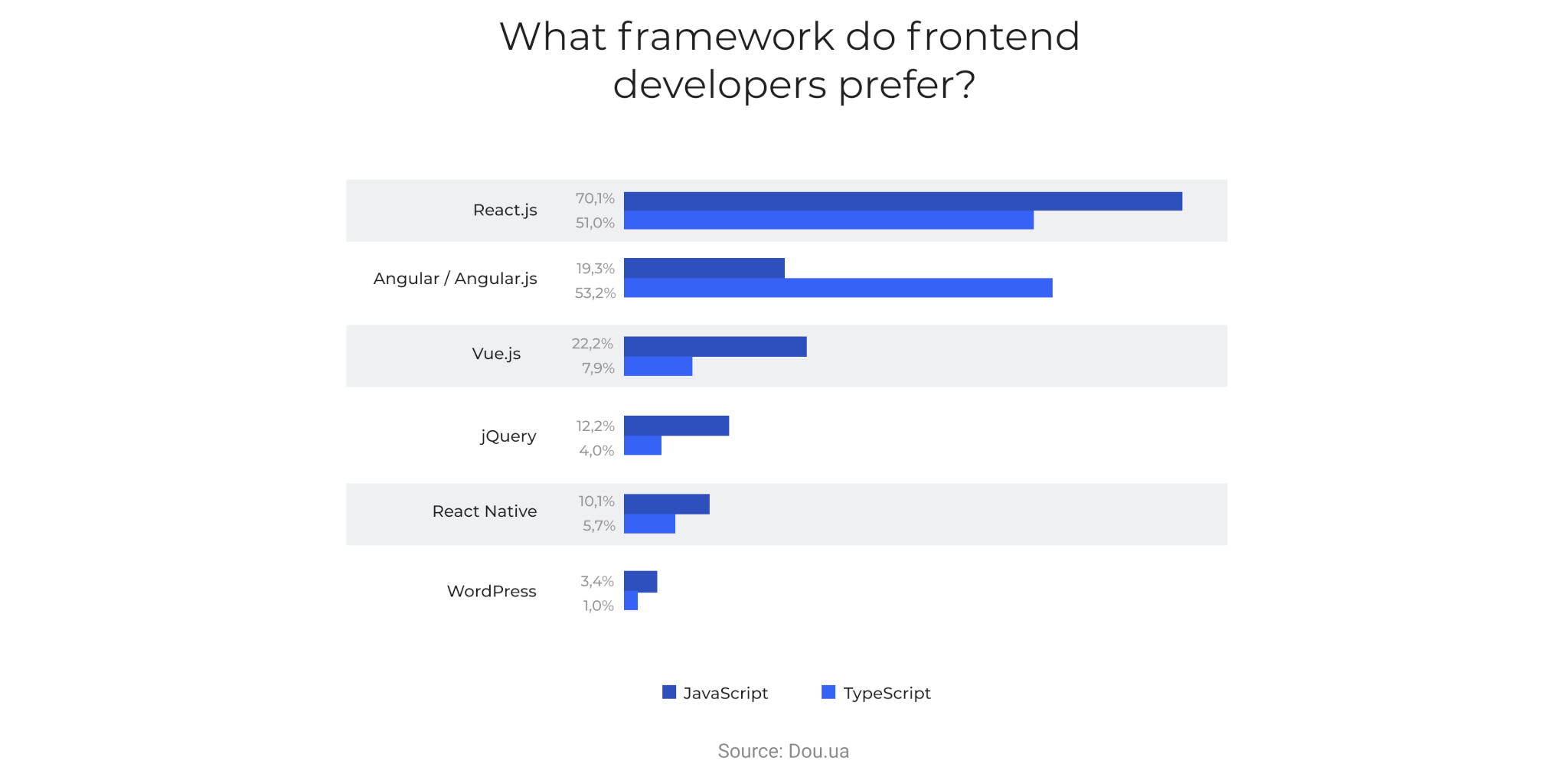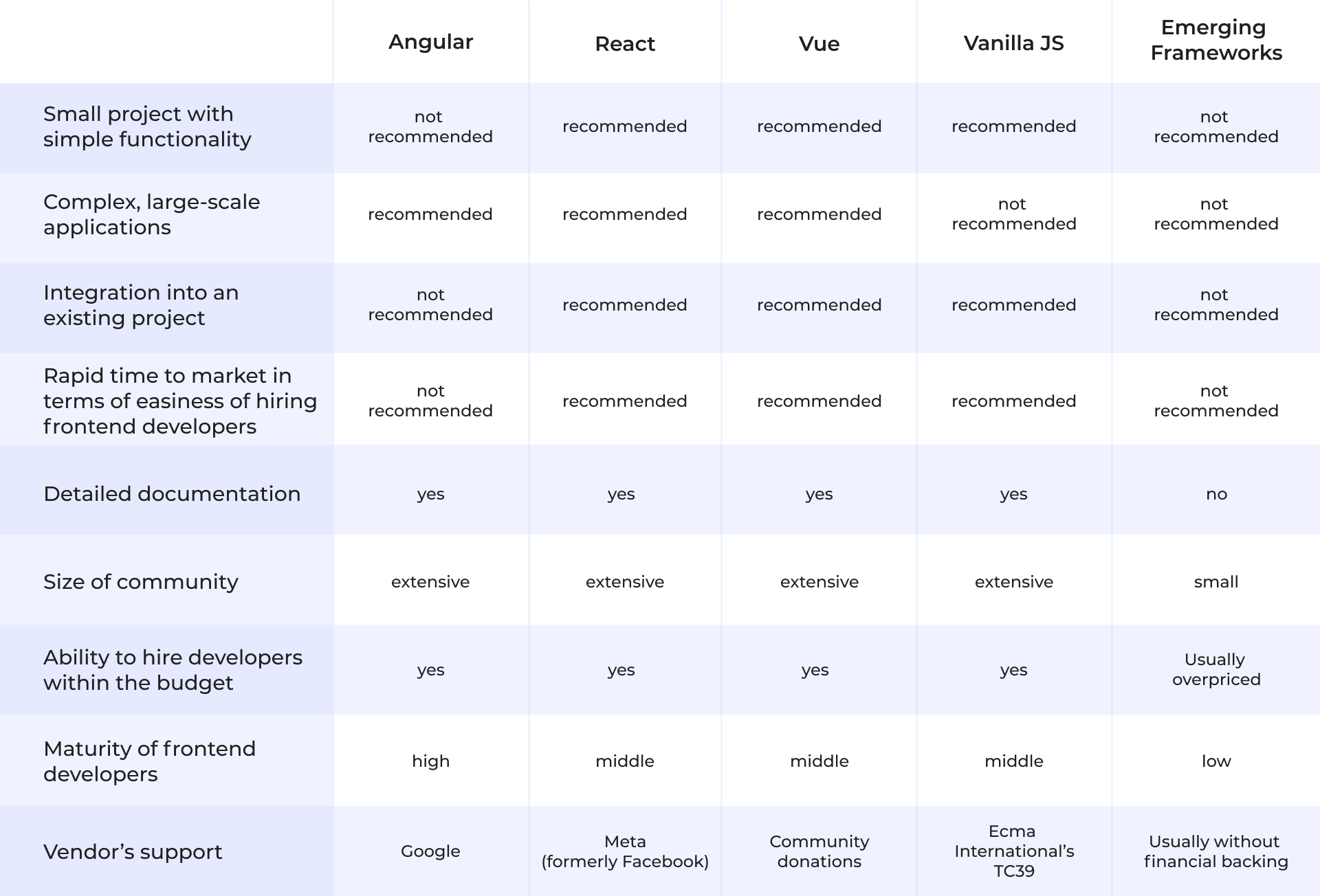How to choose a cooperation model for a software development project
The main cooperation models and their characteristics, criteria and an algorithm for choosing the appropriate model for a software development project.
This is a question most product owners ask themselves at the outset of every new web app development project. Developing a software product involves not only creating a well-designed user interface (UI) and ensuring a convenient user experience (UX) but also building a stable and secure application that will allow you to scale your business easily. This is where having the right frontend technology stack comes in handy.
Each of the top JavaScript frontend frameworks has its own strengths and weaknesses. Different software engineers, product owners and managers have their own opinions as to when it is best to use Angular, React, Vue or other frameworks or simply plain JavaScript code (so-called ‘VanillaJS’).
This article examines some of the most popular frontend JavaScript frameworks and how they compare with one another. We provide a comparison of frontend frameworks and analyse the various perspectives on these technologies in order to facilitate the process of deciding which frontend framework to choose for a given project.
Building software using plain JavaScript code requires software developers to create a code structure from scratch for every new project. Thus, the more advanced and complex an application becomes, the more mistakes are likely to appear in the code. Developers need tools to create a solid code structure and simplify interactions with the Document Object Model (DOM) and application programming interfaces (APIs). Frontend frameworks were created to solve this issue.
A web framework is a reusable, universal software environment that provides engineers with a foundation for developing and deploying applications. The primary functionality of such frameworks is to structure code composition. Today, web frontend frameworks include compilers, support programs, toolsets, code libraries and APIs that bring together different components to facilitate project development.
Although each popular web framework has its own philosophy, they all focus on the following:
Each frontend framework addresses some, but typically not all, of these points. For example, Bootstrap focuses on creating maintainable HTML and CSS, emphasizing consistency in visual design. Bootstrap has an implementation for each framework, so there is no need to use extensive plain JavaScript code. Knockout uses a model–view–viewmodel, or MVVM, pattern but without a solid ecosystem, meaning that the framework offers only a structure. Additional tools, therefore, need to be found elsewhere. Other frameworks, such as React, Angular and Vue, are successful at structuring data flow throughout the application, allowing developers to focus on manipulating the data rather than the DOM.
While building a frontend project from scratch, business owners should consider the project size and budget and the qualifications of team members, among other factors. Next, we discuss each factor that can affect the decision-making process of choosing a frontend framework for web application development.
First, a business owner needs to find and hire frontend developers to form the development team.
Even though most tools are free and open source, product owners still need to hire a development team, whose services can be relatively costly. These high costs might be due to the popularity of the newly appeared technology combined with a still relatively small developer community. In such cases, developers can charge higher costs for a modern approach that might not have a precedent.
To reduce budget, product owners need to look for developers who specialise in the most popular and stable technologies on the market, such as React, Vue and Angular. This strategy enables business owners to find trusted professionals at affordable rates.
The maturity of the frontend development team is also important for the project’s success. Experienced frontend developers usually have strong expertise in several frameworks as well as plain JavaScript.
Among all technologies, Angular has the greatest barriers to entry because, in order to work with Angular, a developer also needs to be familiar with TypeScript and the RxJS library, among others. There is therefore a strong likelihood of project failure if Angular developers are inexperienced. In the event that a development team consists of developers who lack extensive knowledge, it is recommended to choose React or Vue for web application development from scratch in order to avoid this risk.
It is also essential to keep in mind that experienced frontend developers never choose emerging frameworks, as they are typically untested and may lose popularity in a few years. Thus, business owners should understand that, if they choose to use a new framework, it will be difficult to build a team of experienced frontend developers.
The climate of the job market will indicate how easy it is to find and replace developers if needed. It is worth mentioning that most job listings state that they require developers to have experience with one of a few named frontend frameworks. Of those listings, a large share involves hiring for React work. The job market reflects a clear hierarchy of React, followed by Angular and Vue, respectively, according to almost every site sample. It is also worth noting the different cultures of these sampled sites: on all sites, Vue is clearly the third-tier framework, and Angular is not ranked far from React.
Developer salaries are influenced by a number of factors, such as level of expertise, location and mastery of advanced skills. According to data derived from the various sources, React developers have the highest rate on the market, followed by Angular and Vue developers, respectively.

Time-tested frameworks such as React, Angular and Vue can be used for projects of any size. The final result will depend on the developer’s preferences and qualification level. However, there are some recommendations and best practices when using frameworks for particular projects considering their size and specifications.
If the project is small and requires only simple functionalities, VanillaJS is the perfect choice. For medium-sized projects, we recommend using React or Vue, since both web frameworks offer flexible solutions for third-party library integrations and can act as the view layer of backend MVC frameworks.
Angular is preferable for complex and large-scale applications. Angular is more likely to be used in enterprise solutions, which are usually complex and process a large volume of users and funds. Angular has ready-made solutions and a solid structure for most common problems, while TypeScript ensures a rich toolkit for enterprise development and relevant documentation updates.
It is worth mentioning that there is no single rule for choosing a frontend framework for a project. Different projects require different tools and approaches. Before choosing a framework, it is worthwhile to analyse the goals of the project. However, the primary point that business owners should consider is whether the project will be built from scratch or an existing frontend needs to be updated.
When updating an existing frontend, there are several options depending on the technology stack in use. The main advantage of the React and Vue frameworks is that they can be easily integrated into existing frontend solutions. Software developers can gradually edit and update the existing frontend by adding new parts.
However, in some cases, integrating into the existing solution or updating the version of the framework is not an option. As an example, consider Angular.js. Angular.js and Angular v.2+ are two different frameworks with two totally different logics. Therefore, it is impossible to update it with minimal time and effort. Likewise, if an existing frontend was implemented using some technology that is now outdated, it can be easier and more cost-effective to implement a new frontend project with a totally new framework rather than attempting to update the old frontend, which would involve searching for software developers with knowledge of the old technology.
There are some cases when a framework is not necessary. For example, if the project has only one part of the page that is dynamic, it can be implemented using VanillaJS without the need for frameworks. Depending on the specifics of the case, this approach can be used for single-page applications so that only part of the interface changes when switching to a URL, which should be implemented without unnecessary requests to the server.
Time to market is an important factor to consider when choosing a frontend framework. For instance, when creating the minimum viable product (MVP), the short timeframes of software development allow businesses to test a business idea in the early stages and then make a decision as to whether it is worthwhile to implement. If the goal is to ensure that the project is first to hit the market, React is preferable to Angular or Vue due to the popularity of the framework and the size of its community. These factors affect how quickly business owners will be able to find and hire frontend developers.
According to the State of JS, a large majority of JavaScript developers use React, Vue.js or Angular. A total of 10,135,884 websites are built using React, 2,811,694 using Vue and 288,361 using Angular worldwide.
React is the most popular and most widely used frontend framework as indicated by npm download trends. Angular and Vue are ranked second and third in terms of npm downloads. According to GitHub, React is the second most often starred web framework with the second-highest number of contributors after Vue.js. According to The State of JavaScript survey, React and Angular ranked first in terms of usage and awareness.
According to the Stack Overflow Developer survey, React was the most widely used web framework in 2021, with jQuery and Angular taking second and third places, respectively. Starting in 2019, developer communities began to show interest in Vue.js as well as a new framework, Svelte. In contrast, Angular and Ember have not been as popular among developers, perhaps because they typically require a relatively steep learning curve.
Google Trends and Statista both conclude that React, Angular and Vue are the most popular technologies among developers, making them the top three frontend frameworks in both 2020 and 2021.
The popularities of the different frontend frameworks can be explained by several factors.
Popular frontend frameworks have a community of customers and developers around them. This aspect is critical, as it directly affects how much information is available regarding the implementation of the technology. This may include detailed tutorials, forums, meetups and generally the presence of supportive developers who can provide help. The easiest way to check the strength of the developer community of a specific programming language is by checking GitHub or Stack Overflow.
Another indicator is the number of downloads, where React takes the leading position. For example, npm download counts look fairly similar to the search trends but reveal something interesting. While Vue has a solid lead over Angular 2+ in terms of number of downloads, when the number of people using the old Angular framework are added, the difference in downloads between Angular and Vue.js is minimal.

In Ukraine, 70% of frontend developers prefer React for web app development, whereas 22% chose Vue.js and 19% Angular.

A business owner should also take into account that there are specific best practices when using technologies in bundles. For example, using PHP in a bundle with Laravel and Vue or the MEAN stack (MongoDB, Express.js, Angular, NodeJS) are traditions that are widely followed by software developers. In the ecommerce context, it is well-established practice to use a combination of Magento and Knockout. Business owners should take into account the marketplace type and specific project tasks when choosing a framework. When considering particular technologies, certain recommendations will be made in accordance with established practice.
The project’s architecture does not significantly affect which web frontend framework to choose. Nevertheless, optimising the velocity at which the frontend and backend interact is undoubtedly one of the most important aspects of developing a web application, as it directly affects the UX and determines the software project’s success. In such cases, Angular can provide a solid structure.
On the other hand, if the aim is to enhance micro-frontends (meaning that web application UIs are comprised of semi-independent fragments that can be built by different teams using different technologies), it is better to make the size of such apps smaller. In such cases, React or Vue will be preferable.
For ecommerce projects, page loading speed and high performance are very important business requirements. Hence, when choosing a framework for ecommerce platforms, it is best to consider what kind of framework would provide the best possible solution to fulfil this requirement.
Each framework offers its own tools to speed up the application. Overall performance can be traced using a set of metrics that depend on the project’s type. For example, it is possible to consider performance in the context of loading time for the first page. This metric is crucial for ecommerce projects. In this case, React and Vue will be the preferable technologies, as Angular has a large bundle and therefore the out-of-the-box solution will load slower if necessary measures are not taken. The other metric is 60 fps (frames per second), indicating that the page in the browser runs smoothly and does not slow down. This metric is important for information systems. All three frameworks (i.e. Angular, React and Vue) will be suitable in this case.
Angular and React are sponsored by Google and Meta (formerly Facebook), respectively. These frontend frameworks are used by the software developers at these tech giants and thus have the financial support to guarantee that they will be maintained and kept up to date with respect to modern trends. The Vue framework, in contrast, depends on donations from the developer community and the companies that use it.
At the same time, newly emergent frameworks tend to have no proper financial backing. Therefore, there are no guarantees as to their future development and updating. As a result, it is a great risk for business owners to choose such frontend frameworks. Without support from the vendor, the framework may become outdated and subsequently be less widely used among developers. After such a situation came to pass with Knockout, platforms that were developed on Knockout needed to be migrated to Angular, React or Vue. Therefore, choosing time-tested frameworks with proven financial support mitigates the risk of being forced to migrate to other technologies and guarantees an extensive community of software developers.
On the other hand, there is always the option to implement a project without any framework in favour of using VanillaJS. JavaScript is consistently maintained and evolved due to the close collaboration of the JavaScript community with Ecma International’s TC39, an international group of JavaScript developers, implementers, academics and more.
To summarise the frontend framework comparison, we created the following chart.

The success of app development directly depends on the level of a frontend developer’s skills, experience and domain expertise. Every IT service provider has its own indicators that characterise a certain level of developer seniority. At SSA Group, we pay attention to the following criteria: partner certifications, compliance with the matrices of competence, and experience on similar projects.
Businesses go to great lengths to find a software development company that specialises in a certain domain and technology stack. For instance, if a business owner is looking to extend their in-house team to include React developers who work with microservices, the first step is to consider candidates who can provide this type of service and quick staffing, regardless of all other criteria. When you are looking for a specific skill set, you should shortlist vendors who have a proven track record of working in that area.
Before starting a partnership with a specific developer, business owners should check the developer’s experience and identify particular strengths. It is crucial to understand whether a candidate has full-stack experience, experience in architecture design or app testing.
Before hiring a candidate, it is essential to make sure that the frontend developer being hired has experience working on similar projects and in related business domains. Industry experts need less time to find the most suitable solution to achieve business objectives.
When choosing a software development team, every entrepreneur should pay attention to the business flexibility of the IT service provider. This concerns many aspects, such as scalability, ability to adopt new technology, offering of different pricing models and knowledge acceptance.
First, a company should be able to quickly adapt to business owners’ plans and strategies and scale easily as the business evolves. Second, advancements in technology have become so fast-paced that the tech that is used today may become outdated tomorrow. Therefore, it is important to select a software development company that can both keep up with innovations and continue to use time-tested frontend technologies.
In a fast-changing IT environment, choosing the best frontend framework for app development is a crucial element of product success. Frontend frameworks are a powerful tool for developing complex UIs, which make it possible to tap into the most modern JavaScript features and offer tooling that makes it easy to prototype apps.
To help business owners navigate this difficult decision, we discovered several aspects that are important to keep in mind when choosing a frontend framework for web app development, such as project requirements and specifications, talent availability, mobile compatibility, performance, and framework support. Nevertheless, business owners should overall take away that React, Angular and Vue frontend frameworks are equally excellent choices for building a robust and scalable web application. What is most important is choosing a senior tech partner to establish the right direction for the web app development process.
Thank you for reading this article. If you have any questions, please feel free to write to us. We appreciate your feedback and will give you clear and accurate responses. Consider hiring experienced IT consultants at SSA Group to support your software development plans and business growth.

The main cooperation models and their characteristics, criteria and an algorithm for choosing the appropriate model for a software development project.

The market demand for data specialists is growing in proportion to the growth in data volumes. Let’s discuss the areas of responsibility, core competencies and skills.
you're currently offline